Leaving Osaka in the morning after breakfast, I arrived at Shin Osaka station by subway from Honmachi station and boarded the short Shinkansen service towards Kyoto. This was a very short journey and upon arriving at Kyoto, guests of the Hyatt Regency Kyoto can exit at the West exit and walk across Hachijo-dori to the taxi company located opposite the JR Kyoto Station. They will arrange for a complimentary taxi that will bring guests to the hotel. Though it has to be noted the service is valid for one way only. We arrived at about 10 minutes past 1pm, and it was a relatively busy time for check-in. However I was assisted after a short wait, though there was no upgrade to the room I booked as the hotel seems booked. Feeling kind of disappointed since I was expecting an upgrade, I asked if there were possibility of rooms clearing up later in the day, and I was offered another room in an annexe wing, which the receptionist mentioned was a bit of a walk. I did check out the room after getting our room facing the garden on the same floor as the lobby. Since the larger room didn't have a very nice layout and had a worse view on top of a longer walk, I decided to stick with the current room allocation.

Front Entrance to the Hyatt Regency Kyoto
The lobby at the Hyatt Regency Kyoto is unlike any other Hyatt Regency, and for those familiar with Hyatt's branding, the Regency brand is considered one of the lower tier in the chain, but the one in Kyoto is really very well designed and reflects the tradition of crafts in Kyoto. In fact, I find the hotel to have one of the classiest lobbies ever and it exudes the feel of a boutique luxury hotel, not unlike that of the Park Hyatt. Just behind the lobby is the restaurant where breakfast is served, while the floor below houses the Japanese restaurant Touzan. The room I was assigned to was on the same floor as the lobby and a short walk away from the breakfast restaurant making it very convenient.

Lobby and Reception
It was a nicely decorated room and the layout of the room is standard hotel layout with the bathroom on the left upon entrance. An enclosed area houses the bathtub and walk-in shower, while the toilet is a separate room. The remaining space was a bit tight for the sink but it was furnished with a stool. Overall I was pleased with the design of the bathroom and it sure beats the average Hyatt Regency hotels in North America. The design is actually similar to the Andaz in West Hollywood, and even the bathroom amenities are the same by Pharmacopia.

Bathroom Perspective
The bedroom was spacious and elegantly designed as well, with a headboard covered in fabrics that have Japanese embroidery motifs while a chair with an ottoman fronts the huge window overlooking the zen garden. There was also 2 more chairs along the semi-circular study desk that is one whole piece connected to the TV console. There was lots of wood in the decor, making it similar in feel to the Park Hyatt in Seoul. As a welcome amenity I was provided with fresh strawberries in the room and this was really unexpected since strawberries are really expensive fruits in Japan.

Bedroom
In addition to breakfast, we were given a voucher that includes credits for dinner in the hotel's restaurant. Breakfast in the hotel was quite average and while it was superior than many hotel's breakfast, it was average when compared to the one in St Regis Osaka we had prior to coming to Kyoto. One thing I note was the roast beef served during the breakfast buffet and for both days we ate breakfast, seating was more than adequate. On the day we had dinner at Touzan, the food was pretty good, and while not exactly that of a Kaiseki, I did enjoy the set course dinner at the restaurant, and it was not as expensive after the discount applied using the voucher.
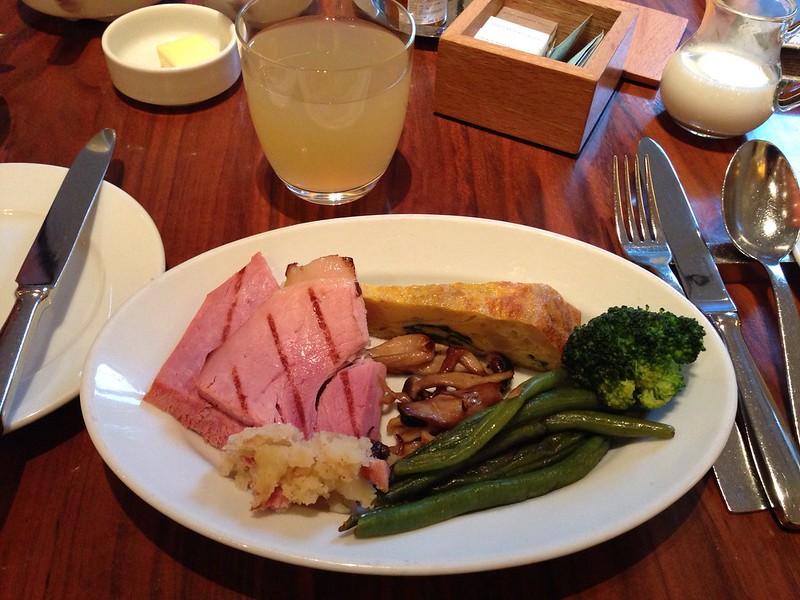
Breakfast at the Hyatt Regency Kyoto
We started touring Kyoto on the first day by visiting the Nishiki Market 錦市場 which is one of the most famous markets in Japan. There was definitely lots of Japanese foodstuff for sale here and plenty of snacks to fill the stomach as we had not have lunch yet. In the end we popped into a sushi restaurant for a late lunch and each ordered a Kyoto sushi set. I definitely love Japan for the fact that each region and city has their own food specialty and the Kyoto sushi set comprised of nigiri and rolls that were more or less unique to the city. The taste was refreshing and if I must say, it was sweeter than the normal sushi sold outside Kyoto. There was also a wonderful scent in the rice which I think might have been from the use of a different type of vinegar in the preparation.
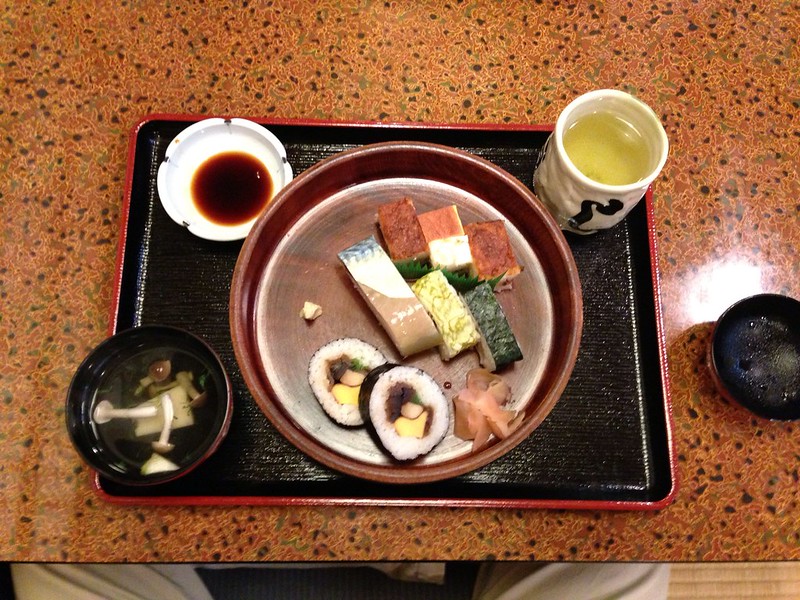
Kyoto Sushi Set at Nishiki Market
After lunch I wanted to check out Nijo-jo, one of the castle in Kyoto, but it was closed by the time we arrived there, and thus we ended up exploring the area around the Heian-jingu 平安神宮. This place is actually a huge park but since it was getting late and ready to close as well, we just took a peek into the shrine and left. Visitors could also visit the Kyoto Municipal Museum of Art since it is in the same vicinity, and the building housing this museum is interesting enough as it combines Japanese architecture forms with a colonial design. To look for the Heian Shrine, just find the huge red Torii archway which marks the entrance to the shrine. It is relatively easy to reach this area by stopping at the Higashiyama subway station and following the stream to the main road. It is a pretty scenic walk amongst the little stream and the residential areas of Kyoto.

Stream in Kyoto
To end our first day in Kyoto, we headed back to Shijo-dori, which is the main avenue that runs parallel to Nishiki market. Shijo-dori is the main commercial centre of Kyoto and between Shijo and Kawaramachi subway station, it is easy to find the major boutiques and several large department stores including Daimaru and Takashimaya. Across the river, one can reach Gion district and find the famed Minami-za Kabuki Theatre. Thus we ended up having a nice meal of Japanese BBQ on our first night in Kyoto at one of the restaurants along the river.

Christmas tree at Kyoto Takashimaya
On the second day, it was definitely off to visit Kyoto's most famous attraction - the Golden Pavilion or known as Kinkakuji 金閣寺. Do note that Kyoto is also home to the Ginkakuji 銀閣寺 (or the Silver Pavilion) which sounds and is written very similarly. We took a subway to the Nijo castle in the morning expecting to visit the castle on the way, but it turns out to be closed that day as well, thus we took a bus from the outside of the castle which will bring us directly to a bus stop close to the Kinkaku-ji. Kyoto is very tourist friendly as it has 3 main bus lines that ply around the major tourist sights and can be differentiated by the normal local bus lines through its colour of red, yellow or green and it is codenamed as the 'Raku' bus with the numbers 100,101, and 102.
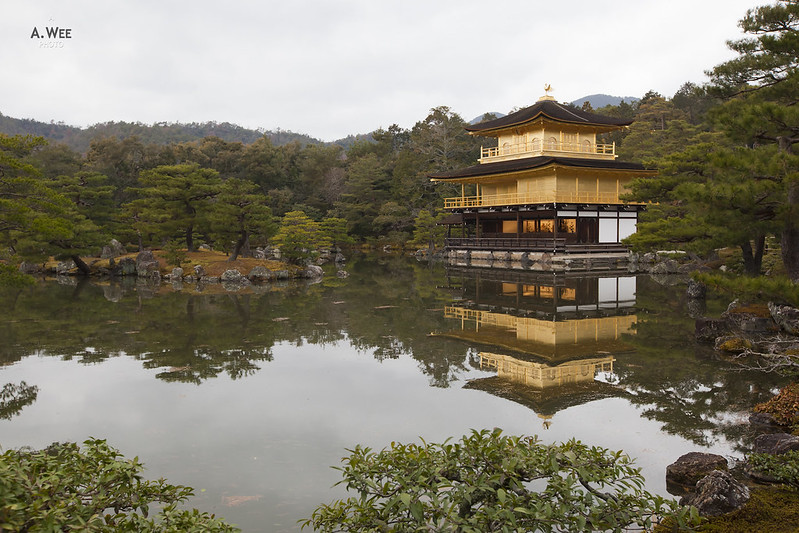
Kinkakuji or Golden Pavilion 金閣寺
It took us around 20 minutes or so to reach the Kinkakuji from Nijo Castle and another short 3 minute walk to the entrance of the Kinkakuji. We arrived in time before the crowds to get some nice photos of the golden pavilion, and the beauty of the pavilion amidst its surroundings are just a sight to behold. Definitely worth it for the trek to head here. Besides the main golden pavilion at the entrance though, there is little else to explore of the area besides a couple of souvenir stands. Traveller should get their lucky charms at the first souvenir stand halfway in the walk across the temple gardens as the shop at the end does not sell as much of a variety. There is also a tea house for visitors to rest their weary legs or warm themselves up during winter and a shrine at the end of the temple grounds.
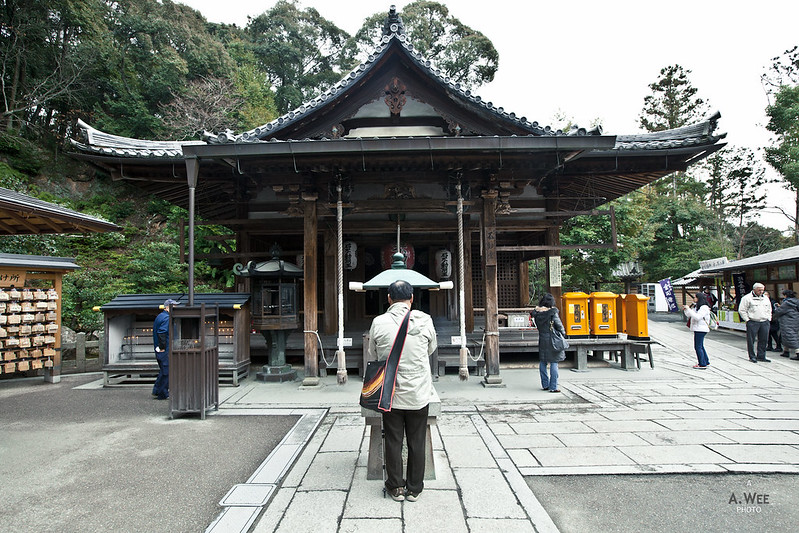
A Man offers his Prayers
From Kinkakuji, we took the Raku bus again towards Ginkakuji, the silver pavilion, and unlike the Kinkakuji, there was an alley up towards Ginkakuji that was lined with shops selling snacks and gifts. This made for a nice leisurely walk towards the temple. Before entering the main gardens of the temple, do take a while to admire the zen courtyard past the ticket booth. The gardens of the Ginkakuji is much larger and was also more beautiful as the addition of sand puddles added a layer of beauty to the garden. Thus while the unfinished pavilion is bare and not coated with silver leaf as one might expect given its name, Ginkakuji offers another sort of tranquility for attraction. For those visiting in spring during the cherry blossom season, there is a path known as the Philosopher's path connecting Ginkaku-ji to Nanzen-ji, another temple in Kyoto that is very popular. Sadly during late autumn, there was nothing much lining the stream along this path as it was all barren trees.
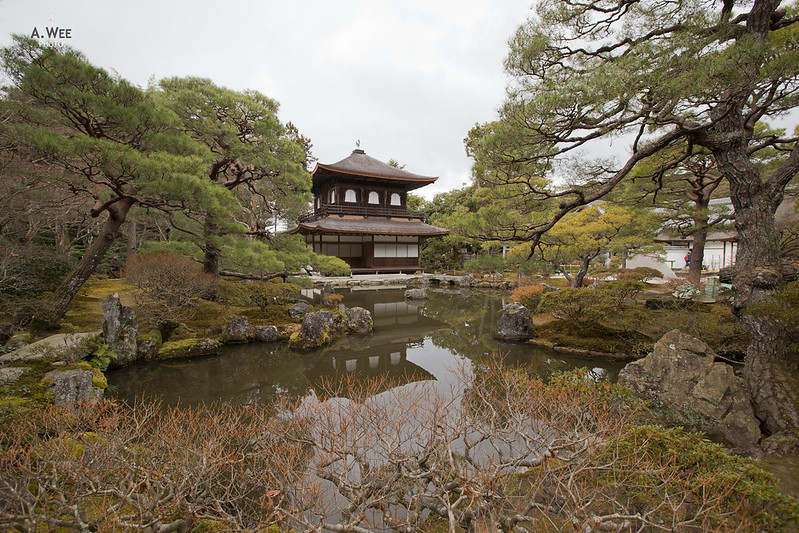
Ginkakuji or Silver Pavilion 銀閣寺
Our last stop for the day was Kiyomizudera 清水寺 which is one of the largest temples in Kyoto and also a UNESCO World Heritage Site. The most enjoyable part about visiting this temple was the market along Matsubara-dori on the walk up to the temple which sells a large variety of foodstuff and gifts. Look for one of the shops selling green tea puffs and tiramisu dessert as they have a nice space to sit down in between the uphill trek to the temple.

Matsubara Dori 松原通
Another good reason to visit the temple is for its amazing views over Kyoto as a result of its vantage position. The main hall has a large outdoor verandah that provides a wonderful view. Besides the main hall, couples would be interested to check out the Jishu-jinja or a shrine dedicated to the Japanese god of love, and hence popularly known as a matchmaking shrine. One thing I noticed was the large number of tourists and locals visiting this temple wearing the traditional Japanese kimono outfit, and I think there are some shops renting or selling these outfits for those who are looking to immerse themselves in the culture.
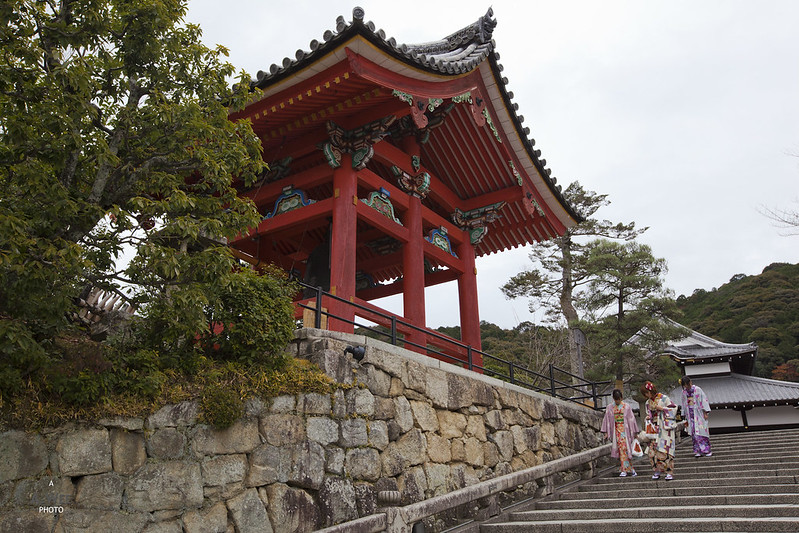
Ladies in Kimono

Lookout over the city of Kyoto
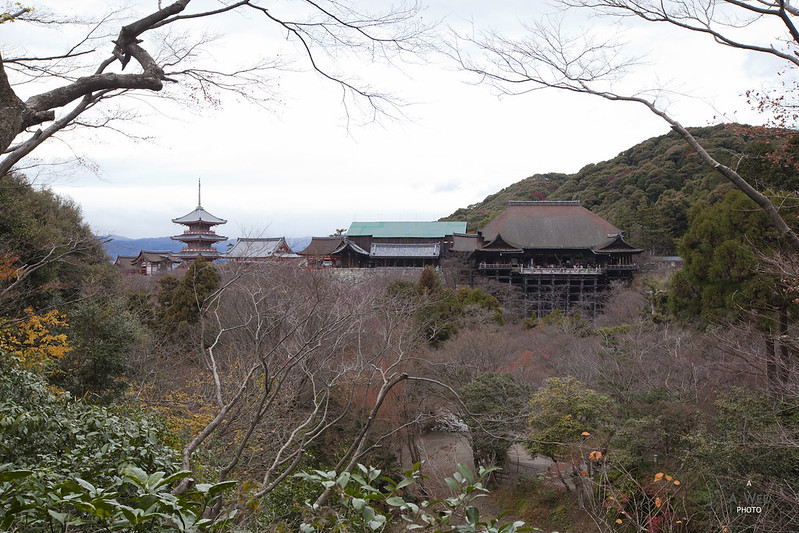
Overview of the Kiyomizudera Temple 清水寺
From the temple, we walked back down and took a leisurely stroll on the main road towards Gion district, the area where Kyoto's famous Geishas entertain their clients. This area supposedly also houses some of the best and most expensive restaurants in town. However with a reservation back at the hotel, we chose instead to have some dessert at Gion Tsujiri 祇園辻利 which is one of the most famous green tea retailer that is also popular for its range of desserts based on green tea. Me and my sister shared a green tea parfait which is highly recommended when in Kyoto.
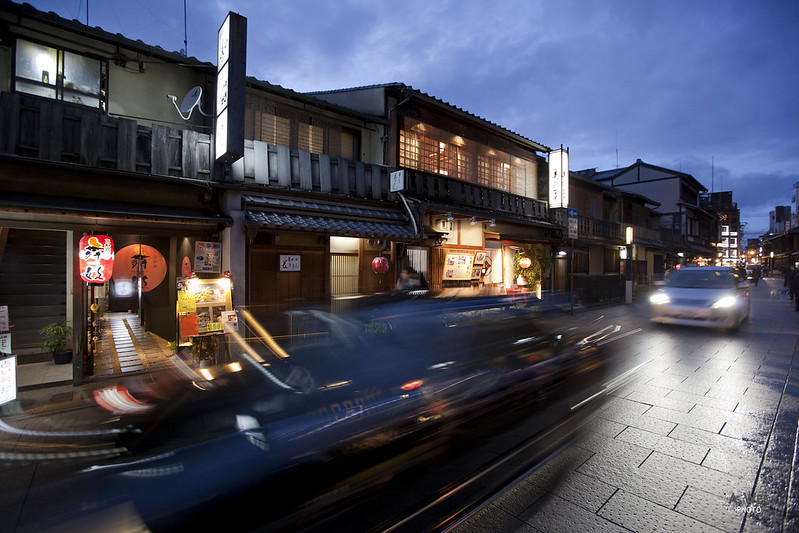
Gion 祇園 district after sunset
Gion district at night is one of the streets to walk around and as I mentioned earlier, the other end of Shijo-dori across the river marks the commercial and shopping are while Shijo-dori to the east of the Minami-za Kabuki Theater is the area where one can find traditional arts and crafts of Kyoto along with dessert stores and Japanese restaurants. This eastern end marked by the grand kabuki theatre Minami-za marks the start of Gion district and it is a pleasant place to spend my last evening in Kyoto.
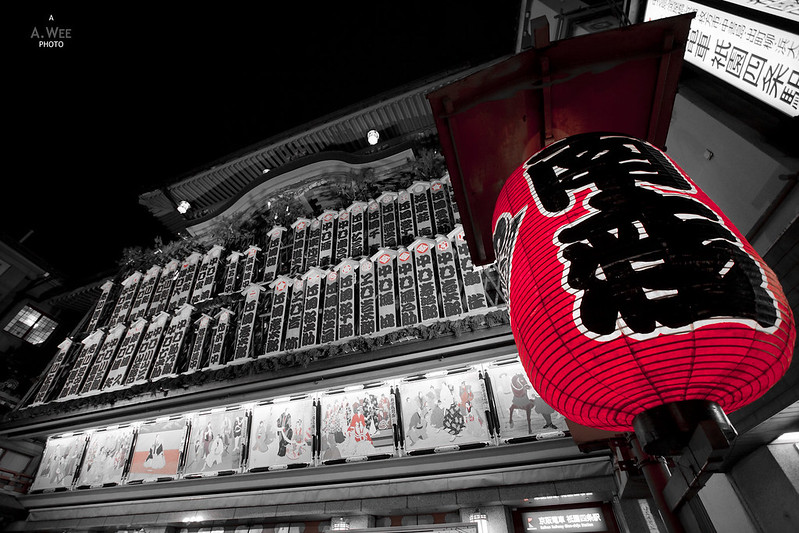
Minami-za 南座 Kabuki Theatre